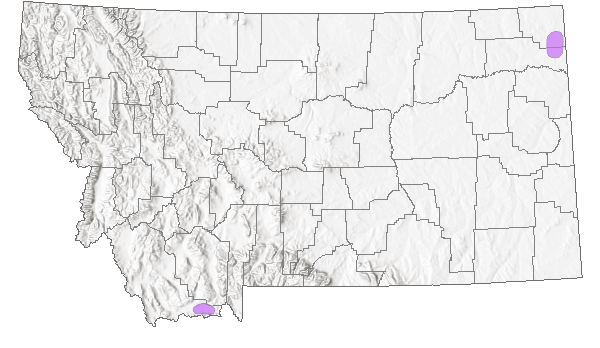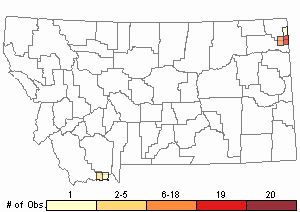View in other NatureServe Network Field Guides
NatureServe
Montana
Utah
Wyoming
Idaho
Wisconsin
British Columbia
South Carolina
Yukon
California
New York
Fendler Cat's-eye - Cryptantha fendleri
State Rank Reason (see State Rank above)
Fendler cat's-eye is restricted to very localized sandhills habitat in the far southwestern and northeastern corners of Montana where it is known from a total of three moderate to large-sized populations. It responds positively to disturbance that maintains its sparsely vegetated habitat. Fire suppression and dune stabilization efforts have likely had an adverse effect on populations of this species.
General Description
Fendler Cat's-eye is an annual herb with simple or branched stems that are 5-20 cm high. The alternate, narrow, strap-shaped leaves may be up to 3 cm long; those at the base are usually brown by the time the plant is fruiting. The foliage is sparsely covered with spreading hairs. Tiny, white flowers are borne on coiled stalks that unwind and elongate as flowering progresses from the base upward. The corolla is ca. 1 mm high and has a small, united portion below and 5 spreading petals above. The calyx is covered with stiff, straight hairs and becomes 4-6 mm long in fruit. Within each fruiting calyx are 4 smooth, shiny, narrowly lance-shaped nutlets that are ca. 1.5 mm long and 1/3 as wide; 1 or more of these may be missing.
Phenology
Flowering occurs from May to early July. Mature nutlets are necessary for positive identification.
Diagnostic Characteristics
Cryptantha fendleri is distinguished by the diffuse branching of its inflorescence and the nutlets, which are lance-shaped and 1/3 as wide as they are long (0.5-0.7 mm wide).
Species Range
Montana Range
Range Descriptions

 Native
Native
Range Comments
B.C. to Sask., south to OR, AZ, NM, and NE. Sparse.
Observations in Montana Natural Heritage Program Database
Number of Observations: 44
(Click on the following maps and charts to see full sized version)
Map Help and Descriptions
Relative Density

Recency



 (Observations spanning multiple months or years are excluded from time charts)
(Observations spanning multiple months or years are excluded from time charts)
Habitat
Cryptantha fendleri is widespread in the western U.S. However, in Montana this species is known only from two large sandhill areas at opposite corners of the state - the Centennial sandhills in Beaverhead County, and the Medicine Lake sandhills in Sheridan County. It grows in open areas of sand dunes, and occupies a range of sparsely vegetated sites and successional stages. In the sandhills of Sheridan County, it was found not only in blowouts, but throughout much of the gentler sandplains where grass cover is patchy. Associates there include Oryzopsis hymenoides, Psoralea lanceolata, Stipa comata, Sporobolus cryptandrus, and Cyperus schweinitzii. Associates in the Centennial sandhills include Allium textile, Elymus trachycaulus, Stipa comata, Eriogonum ovalifolium, Psoralea tenuiflora, Phacelia hastata, and Astragalus ceramicus.
National Vegetation Classification System Groups Associated with this Species
Grassland
Lowland - Prairie Grassland
Ecology
Population sizes of this annual species can fluctuate widely from year to year, depending on conditions. The species is restricted to very sandy soils of early successional habitats, favoring the crests, upper slopes and blowouts of sandhills. Like many other rare plants of the sandhills, this species requires the open sand of early successional areas, and declines when plant succession leads to later stages in which vegetation fully colonizes areas of formerly open sand. These open habitats are maintained by a combination of wind, fire, and grazing by both livestock and small mammals (Lesica and Cooper 1998). Some level of disturbance can help maintain the early successional habitat required by this plant. At one locality, C. fendleri was found growing along livestock trails and old roads.
Management
The removal of natural disturbance regimes, including fire, ungulate grazing and pocket gopher activity, can result in dune stabilization, reducing the extent of early seral blowout vegetation upon which this species depends. It would benefit from restoration of the fire regime and/or moderate grazing, at least in years following burns. Fendler cat's-eye does not grow among tall, dense grasses, and the practice of seeding sandhills areas to crested wheatgrass (Agrpopyron cristatum) has reduced available habitat. It has been found to persist under heavy grazing, and also grows where brittle pricklypear (Opuntia fragilis) is common and indicates past heavy grazing. Severe destabilization of the dunes, e.g., from off-road vehicle use, can also damage this species' habitat.
Stewardship Responsibility
Threats or Limiting Factors
STATE THREAT SCORE REASON
Reported threats to Montana's populations of Fendler’s Cat’s-eye concern the disturbance regime necessary to sustain its habitat (MTNHP Threat Assessment 2021). Fendler’s Cat’s-eye establishes on sand dune blowouts resulting from frequent wind erosion. Occasional fire disturbance is likely to have an important role in preventing long-lived vegetation from establishing on dunes. Management actions that interrupt disturbance events such as dune stabilization and fire suppression threaten populations by degrading habitat quality, and eventually reducing the area of suitable habitat.
References
- Literature Cited AboveLegend:
 View Online Publication
View Online Publication Lesica, P., M.T. Lavin, and P.F. Stickney. 2012. Manual of Montana Vascular Plants. Fort Worth, TX: BRIT Press. viii + 771 p.
Lesica, P., M.T. Lavin, and P.F. Stickney. 2012. Manual of Montana Vascular Plants. Fort Worth, TX: BRIT Press. viii + 771 p. MTNHP Threat Assessment. 2021. State Threat Score Assignment and Assessment of Reported Threats from 2006 to 2021 for State-listed Vascular Plants. Botany Program, Montana Natural Heritage Program, Helena, Montana.
MTNHP Threat Assessment. 2021. State Threat Score Assignment and Assessment of Reported Threats from 2006 to 2021 for State-listed Vascular Plants. Botany Program, Montana Natural Heritage Program, Helena, Montana.
- Additional ReferencesLegend:
 View Online Publication
View Online Publication
Do you know of a citation we're missing? Culver, D.R. 1993. Sensitive plant species inventory in the Centennial Valley, Beaverhead County, Montana. Unpublished report to the Butte District, Bureau of Land Management. Montana Natural Heritage Program, Helena, 42 pp. plus appendices.
Culver, D.R. 1993. Sensitive plant species inventory in the Centennial Valley, Beaverhead County, Montana. Unpublished report to the Butte District, Bureau of Land Management. Montana Natural Heritage Program, Helena, 42 pp. plus appendices. Culver, D.R. 1994. Floristic analysis of the Centennial Region, Montana. M.Sc. Thesis. Montana State University, Bozeman. 199 pp.
Culver, D.R. 1994. Floristic analysis of the Centennial Region, Montana. M.Sc. Thesis. Montana State University, Bozeman. 199 pp. Heidel, B.L., S.V. Cooper and C. Jean. 2000. Plant species of special concern and plant associations of Sheridan County, Montana. Report to U.S. Fish and Wildlife Service. Montana Natural Heritage Program, Helena, Montana. 96 p.
Heidel, B.L., S.V. Cooper and C. Jean. 2000. Plant species of special concern and plant associations of Sheridan County, Montana. Report to U.S. Fish and Wildlife Service. Montana Natural Heritage Program, Helena, Montana. 96 p. Lesica, P. & S. V. Cooper. 1998. Succession and disturbance in sandhills vegetation: constructing models for managing biological diversity. Conservation Biology 13:293-302.
Lesica, P. & S. V. Cooper. 1998. Succession and disturbance in sandhills vegetation: constructing models for managing biological diversity. Conservation Biology 13:293-302. Lesica, P., M.T. Lavin, and P.F. Stickney. 2022. Manual of Montana Vascular Plants, Second Edition. Fort Worth, TX: BRIT Press. viii + 779 p.
Lesica, P., M.T. Lavin, and P.F. Stickney. 2022. Manual of Montana Vascular Plants, Second Edition. Fort Worth, TX: BRIT Press. viii + 779 p. Quire, R.L. 2013. The sagebrush steppe of Montana and southeastern Idaho shows evidence of high native plant diversity, stability, and resistance to the detrimental effects of nonnative plant species. M.Sc. Thesis. Bozeman, MT: Montana State University. 124 p.
Quire, R.L. 2013. The sagebrush steppe of Montana and southeastern Idaho shows evidence of high native plant diversity, stability, and resistance to the detrimental effects of nonnative plant species. M.Sc. Thesis. Bozeman, MT: Montana State University. 124 p.
- Web Search Engines for Articles on "Fendler Cat's-eye"





